Buffy the Vampire Slayer and Charmed: The Re-Feminization of Female “Superheroes”
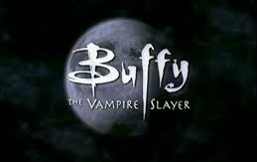
The television shows, Buffy the Vampire Slayer and Charmed, are often touted as examples of “post-feminist” shows, which feature female leads that transcend the typical media boundaries of females. Buffy the Vampire Slayer centers around a teenage girl, Buffy, who discovers she is the “chosen one,” the one girl with the power to fight evil. Similarly, Charmed focuses on three sisters who discover that they are the most powerful witches in the world and who go on to fight evil. Indeed, both shows are ground-breaking, in that they demonstrate strong female characters in the role of a “superhero.” This role is normally portrayed by a male. The fact that these shows choose to have females fill this role is a great advancement in gender depictions on television. However, in order to make these gender bending choices of a female superhero less threatening to masculinity, the shows underwent a process that can be called “re-feminization.” The shows, Buffy the Vampire Slayer and Charmed, demonstrate this process through sexualizing the female leads, including a male guiding or authority figure, and the concept of “feminine vulnerability.”
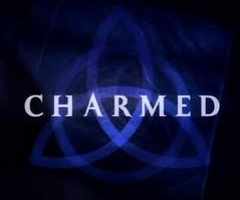
1. The Eroticization of the Female Lead
While both, Buffy and Charmed, arguably feature independent and strong female leads that take on a traditionally male role of saving the world, the shows include blatant eroticization of their female leads. This is arguably done to make the shows more accessible and enjoyable for their male viewers. Predictably, this eroticization is done through the characters’ wardrobes.
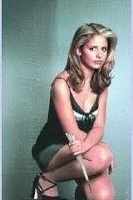
In Buffy the Vampire Slayer, the show is marked by not just by the super-human strength of its “chosen one” girl, but by the skimpy outfits in which she fights the forces of darkness. In particular, the first and second season, are marked by Buffy fighting vampires and demons in midriff baring, low-cut tops and tight mini-skirts. As the series progressed, Buffy continued to fight evil in high-heels and tight leather pants. These pants eventually became her trademark. Thus, Buffy became not only a strong fighter of evil, but a sexual object, eroticized for the benefit of the show’s male viewers.
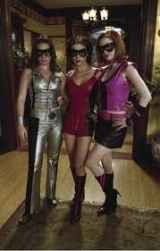
Charmed also included the process of sexualizing its female leads. Each of its three female leads is often featured wearing tight, revealing clothing. In fact, the skimpy outfits became so much a part of the show that several episodes involved transformations that feature the witches in revealing costumes. One such episode is titled “Witches in Tights.” This episode ironically features the witches transforming into comic book superheroes. The three leads transform into stereotypical comic book female superheroes, skimpy leather outfits included. Another episode features Phoebe, one of the witches, changing into a mermaid. The outfit includes a shell bra and little else. Yet another episode has Phoebe transforming into Lady Godiva. She spends almost the entire episode naked, cloaked only by her suddenly long hair. Like, Buffy, the witches in Charmed, while still superheroes, have become incredibly eroticized sexual objects. The focus of these episodes becomes overshadowed by the extreme attention given to the revealing and sexualized wardrobe that the female characters wear.
2. The Male Guiding/Authority Figure
In addition to the eroticization of its female leads, the shows re-feminize their female “superheroes” by the inclusion of male guiding/authority figures. The implication of these characters is that the female “superheroes” cannot function, or at the very least, cannot function effectively without the presence and advice of a male guide.

The show, Buffy the Vampire Slayer, features this character primarily in the form of Giles, Buffy’s British “Watcher,” and peripherally in the characters of the nearly all-male Watcher’s Council. Giles’ character acts as a pseudo-father figure towards Buffy, increasing his authority over the character. In addition, Giles is introduced to the show as the high school’s librarian. In this way, he is given the role of “teacher” and thus given even more authority over his young, female “superhero.” In his role as a “Watcher,” Giles is the ultimate authority and guide for the female “superhero” of Buffy. The female lead often goes to Giles for advice on how to face a particular threat or evil being. In addition, the show often features Giles bringing the evil creature of the week to the attention of the “slayer” and it is often he that decides the best possible fighting option. Buffy, in a sense, becomes little more than a tool that her male watcher uses to fight evil.
Buffy the Vampire Slayer takes the essential nature of the male guiding figure one step further. In a late season, the show features an episode where Giles leaves, returning to England and abandoning the “slayer.” Buffy pleads with and even begs her “Watcher” not to leave, revealing her character to be an emotional mess without her male guiding figure. The show also features an almost completely male “Watcher’s Council,” whose role was to preside over the slayers. In fact, the only female “watcher” featured on the show turns out to be evil and in need of “slaying.” Thus, a female character is seen as incapable of being in such an authority role without turning or succumbing to evil. In addition, a male guide is needed for the female “superhero,” in this case a “slayer,” to function effectively. This is evidenced by how Buffy falls into an emotional mess when her watcher leaves her, in a sense taking a strong, almost “masculine” character and turning her into a traditionally emotional, weak “feminine” character.
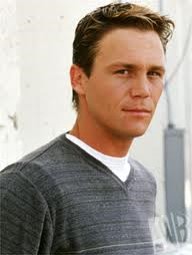
The show, Charmed, also includes in its characters a male guiding/authority figure. Charmed presents this type of character in the figure of Leo, the witches “Whitelighter” or guardian angel. In addition, much like Buffy’s Watcher’s Council, Charmed features a nearly all-male higher authority, known as the Elders. Much like the character of Giles, Leo acts as a decisive authority and guiding figure for the female “superheroes” of Charmed. He often acts as the witches’ encyclopedia, offering a never-ending supply of information and experience about various demons. He is also irreplaceable as the giver of advice and guidance. In the episode, “Oh My Goddess (Part Two),” the witches have to face the all powerful Titans. Leo has become an Elder, a promotion to a higher level of authority, and is thus temporarily unavailable to offer advice to the girls before the battle. As a result of Leo’s absence, the witches are plagued by doubt and fear. It is not until Leo comes down and offers his sage advice that the witches are able to fight competently against evil.
In Charmed, the Elders function in much the same way that the Watcher’s Council do in Buffy the Vampire Slayer. An almost entirely male force, they act as the ultimate authority in the magical world of the show. Leo often goes to the Elders to get information on an evil and to gain advice on the best way to proceed. In addition, the Elders often issue orders or warnings about a future evil and how to react. For most of the series, the Elders and whitelighters are almost exclusively male. For the most part, the only female whitelighters featured on the show are either immediately or eventually killed by some evil that the witches are facing. In fact, the only whitelighters killed on the show tend to be female, indicating the implied superiority of males in the role of guide or authority. The fact that only female whitelighters are killed or particularly vulnerable to attack is never mentioned by the female leads. It does not become an explicitly stated gender norm in the show, but rather only one that is visually demonstrated in the show’s plot. Thus, Charmed emphasizes the weakness inherent in the traditional thought of femininity by implying that a female cannot function without a male guide and that a female guide cannot escape the evil that the male guide’s help protect their witches from.
3. The Concept of “Feminine Vulnerability”
Both shows “re-feminize” their female leads by sexualizing them, including a male guide, and finally by the inclusion of an element that I will call “feminine vulnerability.” The element “feminine vulnerability” includes the emphasis and inclusion of stereotypes about female vulnerability in regards to evil, and the treatment of female sexuality in comparison to male sexuality. Buffy the Vampire Slayer and Charmed both include this aspect of “feminine vulnerability” by having their female “superheroes” be exceptionally susceptible to the temptation of evil, something that shows with male “superheroes” often have their lead characters be able to resist.
For example, Buffy the Vampire Slayer focuses on the aspects of “feminine vulnerability” that deals with feminine sexuality. The show positions female sexuality as dangerous. This is shown through the relationships that the show’s female “superhero,” Buffy, engages in. First, one can look at how the show handles the loss of female virginity in comparison to how it treats the loss of male virginity. When Buffy loses her virginity to Angel, her vampire-with-a-soul boyfriend, she triggers a loophole in his curse, causing him to lose his soul and revert back to his evil nature. The following season shows a Buffy weakened by the emotional blows a monstrous Angel causes by tormenting her and killing her friends. The show even goes on to have a now evil Angel nearly cause the end of the world. The implication is, of course, that female sexuality is extremely dangerous. In the case of Buffy, it is even world threatening. Buffy the Vampire Slayer also includes an episode that deals with male loss of virginity. When Buffy’s male sidekick, Xander, loses his virginity, he is empowered by it, feeling more manly and confident. He is even able to save the world from a zombie attack that included the zombies planting a bomb on top of a portal to Hell. The distinction is clear: female sexuality is dangerous, male sexuality is empowering.
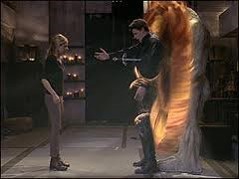
Buffy the Vampire Slayer also demonstrates “feminine vulnerability” in the treatment of Buffy’s other relationships. The show further emphasizes the dangers of feminine sexuality in the episode in which Buffy and her boyfriend, Riley, engage in all-night sex at a fraternity party, unleashing a dangerous spirit and endangering the other party-goers. In fact, the episode states that the evil spirit feeds off of and gains strength from the pair’s sexual activity, indicating that the spirit never would have been a danger if not for Buffy having sex. This is much like how Angel never would have been a danger if Buffy had not slept with him. Buffy the Vampire Slayer also delves into an abusive relationship when it pairs Buffy with a still soulless vampire, Spike. The show features eroticized violence, often pairing the couple physically fighting with each other with them having sex. The relationship culminates in an attempted rape, in which the female “superhero,” Buffy, is “re-feminized” as a weak female, vulnerable to male attack. This is a clear departure from the normally “masculine” strong fighter that Buffy is. Once again, the show is demonstrating how female sexuality is dangerous and vulnerable.
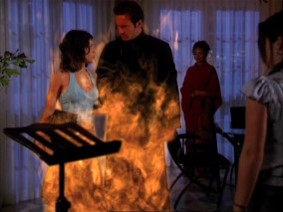
Charmed treats the element of “feminine vulnerability” differently from Buffy in that it deals primarily with female susceptibility to evil. In many cases, this susceptibility coincides with a sexual relationship. For example, the show often has one of the female leads, Phoebe, give into evil temptation. Phoebe falls in love with a demon, Cole, who was sent to kill her and her powerful sisters. Even when she finds out about his agenda, Phoebe protects Cole and continues a relationship with him. Later, when she discovers that he has become the Source of All Evil, the ultimate evil on the show, she remains with him, turning evil herself for a brief period of time. It isn’t until the interference of her sisters and the male guiding figure of Leo, that she turns her back on her evil husband and returns to the side of good. Having Phoebe become susceptible to evil seduction is not unfamiliar for Charmed. The show features an episode that exhibits one of Phoebe’s past lives. In this past live, Phoebe succumbs to the seduction of an evil warlock, Anton, turns evil and attempts to kill her sister’s past selves. Thus, Charmed “re-feminizes” a strong female “superhero” by making her vulnerable to turning evil, often because of a romantic relationship.
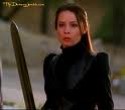
Charmed also demonstrates “feminine vulnerability” to evil in cases that do not involve a romantic association. For example, the show features an episode in which one of the female leads, Piper, becomes seduced by the power of Excalibur (the sword) and in a sense turns evil with it. She becomes all consumed with power and neglects all of her traditionally feminine roles, including the all-important one of mother. After she returns to good, she is seen playing with her son and remarking that she has her priorities straight now. The implication is that despite the extreme power of the female Charmed Ones, a female is still susceptible to being turned evil by too much power and that she should not neglect the traditional female roles, such as that of mother. In the final season, a new female lead, Billie, gives into the temptation of trusting her long-lost sister, who has turned evil. Billie briefly goes “evil” as well and betrays the Charmed Ones, redeeming herself at the last minute. In this case, the implication is that females are vulnerable to the seduction of evil, where their male counterparts are seemingly not. This is seen most strongly in the case of Wyatt and Chris, one of the female lead’s, Piper’s, sons. Wyatt turns evil in the show, but his brother is able to resist and instead goes about trying to restore his brother to good or stop him. Billie gives into her sister and turns “evil” while Chris resists his brother and fights for good. It is clear that the implication is that females, despite their witchy power on the show are much more vulnerable to evil than their fellow male characters.
The television shows, Buffy the Vampire Slayer and Charmed, both feature strong, independent female “superhero” characters. However, both shows also include elements that “re-feminize” these female “superheroes.” By sexualizing their wardrobes, the shows lessen the threat that these characters, who take on the traditional male role of saving the world, are too masculine. The inclusion of male guiding/authority figures in the shows, reemphasize a traditional hierarchy with males on the top and females needing their guidance. Finally, the shows demonstrate “feminine vulnerability,” illustrating their strong female characters as weak and susceptible to evil. That is not to say that these shows were not groundbreaking in their treatment of strong female leads. Nor is it to limit the gender bending qualities of these shows. However, both Buffy the Vampire Slayer and Charmed do have elements that “re-feminize” their strong female leads in order to make them less threatening to masculinity.
What do you think? Leave a comment.
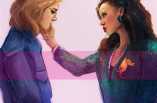
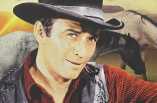





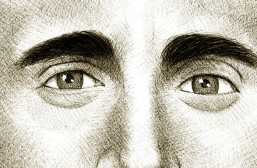

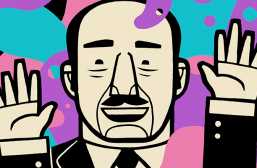
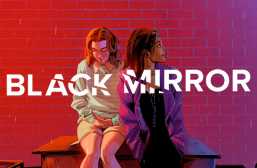
HI, Nice article! I know both of these programmes afar to well and I think you make some good points, but i do disagree with a couple of places.
The point of women in Charmed being more suceptible to evil seems a little forced: There are several instances in the show when the male ‘good characters’ turn as well. Leo goes bad at one point and has to be bought back to the light. Gideon is likewise a male authority figure that turns very evil. I think that the show is fairly balanced on that part – everyone is suceptible regardless of gender.
There is also an episode of Charmed where they get a female WHitelighter and she makes them wear comfortable clothes to be more effective at fighting evil. Maybe I am reading too much into it, but when she dies at the end I thought it represents that ‘extreme feminism’ (i.e men are crap but we should be like them..) can be as dangerous misogony. (ok, i’m reading too much into it!!)
I also take slight contention with the bit about Giles leaving Buffy and leaving her a mess. Giles leaves because he believes in Buffy when she does not. This is one of the ealiest examples of a ‘HeforShe’ concept. Surely Giles is being the ulitmate feminsit here, pushing Buffy to be all she can be?
*earliest examples of HeforShe on TV anyway
Hi Francesca! Thanks for your feedback. I totally understand your points of disagreement. I love these shows. As for the male “good characters” turning evil as well–we, as an audience, never actually see Gideon as a good guy. He masquerades for a few episodes, but the entire time he is on the show he is “evil” and trying to stop Wyatt. We only know about when he was good from other characters memories of him.
As for Leo, turning “evil,” I would have to disagree that he does. He definitely loses it for a while and kills two elders…but it was a reaction to being betrayed by his boss and friend. (and to protect his family). The female characters that turn evil does so for romantic love or because of the influence of intense power (for the most part) and are “evil” for longer or do more destructive (at least pointless destructive) things. (this is of course, my opinion and I greatly respect yours).
I have to say that I like the idea that the one female whitelighter was an example of extreme feminism. I never thought about her that way. I guess my point was just the sheer lack of visible female whitelighters there are in the show, who survive. Paige is really the only one that we see for an extended period and for most of the show, her role of Charmed One (under the guidance of a whitelighter) is more important than her role as a whitelighter (providing guidance).
Finally, your point about Giles. I do not disagree with Giles intention in leaving, or in what it meant for the character thematically on the show. It was more the decision that the show made to have their strongest female character so dependent on her father figure that she would fall apart once he leaves. I just find it interesting. I completely agree that the Character of Giles was a feminist.
I don’t think that any of my ideas take away from the fact that these shows were feminist—they were just interesting twists and tropes that I found that are problematic to that feminist legacy. Not necessarily because they exist but primarily because they did not exist in equal measure for male characters.
Good points. Oh good, I wasn’t totally crazy with the female whitleighter theory!
Bookworm excellant article, thank you for bringing attention to the sexualization of lead female actors. Very well done!
Very well written article. Your points are well developed and you offer clear arguments and examples.
As an observer of the evolution of this type of TV programing over the last few decades, sadly, there is no real progress. If anything, it seems, in my opinion, that this type of female character has been degraded further.
Check out the 1970’s TV show Charlie’s Angels and you will see that the elements you discussed in Charmed directly parallel the elements in Charlie’s Angles in a patriarchal portrayal of females in “power” roles.
Another show that is interesting from the 70’s is The Bionic Woman: a single female character with “superhero” powers and a males mentor. But at least the lead is intelligent and fully realized.
In my opinion, it doesn’t seem we have progressed in the last four decades. In fact, I wonder if we have’nt gone backward and degraded the “female in power role” to an outrageous level. The female roles in both The Bionic Woman and Charlie’s Angels were, at the least, played and portrayed by women who were mature adults. The characters in both Charmed and Buffy are played and portrayed by emotionally and psychologically underdeveloped girls.
Buffy may not have been overtly or expressly Feminist, but it definitely explored complex issues like gender equality, sex, relationships, alienation, addiction, sexuality, and more, through nuanced drama and storytelling.
Absolutely!
Great, well written and researched!
Thank you!
Hi there! I’ve been a buffy-addict for around 7 years or so (I came to the series after its run but quickly devoured and re-devoured it since). Once I started stumbling into the critical analysis of other superfans I quickly became obsessed with that aspect of the fandom as well.
I am greatly encouraged that this great television series (the best of all time, imho)continues to be explored and get the discussion it so richly deserves. It was through the works of Joss Whedon that I had my philosophical awakening and was able to grow up in my own way from a spectator of pop culture (and my life in general) to a participator in its discussion and formation.
I think that I’ll really appreciate a re-watch of the Charmed and BTVS. I know there were lots of things I didn’t see — connections, storylines, etc. — the first time through.
The more I think about Buffy and feminism, the more I realize she’s a strong female character in a similar way to how Uhura in TOS was a strong black role model.
Buffy was a strong female role model largely because she was one of the only female role models on TV who could kick that much ass and who was physically stronger than the men around her. But if you think about her personality as an individual character as opposed to as an icon or a representative for her gender, Buffy was always kind of a girly girl who liked shopping and the mall and boys and cute shoes, and sometimes I think her dependence on the men in her life came from [the fact that her dad was gone and also] a desire to be normal and have someone take care of her for a change. That’s just human.
I think it’s also worth mentioning that Sara Michelle-Geller was portraying a teenager. Young women and men are often a little self-conscious, overly dependent, and in need of peer approval. If we look at her that way, I think she’s the most well-adjusted, intellectual teenage girl portrayed in the ’90s.
That is definitely true. Great point.
Thanks so much for this analysis – it speaks to a lot of things I’ve argued over the years.
While I really enjoy the analysis of shows which people generally take for granted, I believe a lot of what’s said here is slanted. Can you honestly say that women were portrayed in ways which men weren’t?
I see less of a problem with women depending on others (men or women) and have more of an issue with the fact that women with any sort of sexual agency are routinely punished, humiliated, and degraded for owning their sexuality. It seems that the media and society at large think that sexual equality is a dangerous thing indeed. I think that, biologically speaking, the fact that men can’t have babies is in a large part responsible for this mentality. Kinda makes you want scientists to get cracking on making test tube babies work. That certainly seems more likely to happen than people growing up and getting over themselves and their stupid prejudices.
Interesting to see analyses of BtVS & Charmed still alive a decade later.
In many ways, Joss Whedon’s work as a writer and editor was groundbreaking and revolutionary to television and American storytelling.
Buffy and Charmed are my favorite work. I re-watch the entire series frequently and often find myself perusing the web and reading articles about some aspect of it. One of the reasons I enjoy it so much is that I always find something new to reflect on. I just wanted to thank you for taking the time to share your thoughts and your work with others. It is appreciated.
What I like about this piece is that we see an alternative viewpoint to the ‘popular critic’s’ opinion. Sometimes I find TV critics hop on a bandwagon like you mention––’strong female lead, etc.’––and, in actuality, there is something else going on… This article culture-jams these ‘popular’ perspectives in a way––I really appreciate that.
I look forward to more analyses! (and in the long run, hopefully more women characters on TV and in films that don’t make me cringe in dismay.)
As an English teacher, very little thrills me more than a hearty, thorough analysis and interpretation, so I look forward to reading more content on this magazine!
A great tribute to both shows.
I’m really not a huge fan of Joss Whedon to begin with as I find he tends to forget the huge talent of collaborators he has always had for all his most successful endeavours but I offer a few thoughts to the idea that his strong female characters tend to always still rely on men anyway.
Hey there! Absolutely loved your article! I’ve always considered Buffy a powerful and complex female character, yet I liked how you brought attention how she’s also sexualized. Well done!
Very interesting points.
Buffy literally brought me out of my intellectual shell; Joss made it OK to subvert and dissect stereotypes, cliches, tropes, expectations, conventions, traditions and gave us hope in the form of one of the greatest literary heroes of all time (if not ‘The’).
Impressed by the article above.
I have never watched Charmed before, but if its anything like Buffy then it sounds like a great watch. Awesome article.
Well done! I’m a huge fan of Buffy but I haven’t watched Charmed in ages. I particularly liked your section on “female vulnerability.” I can’t believe I didn’t pick up on that trope before.
Great article, really is going to help me view these shows a little different;y, I am a huge fan but I never really thought of the dramatization of sexuality in the shows.
I’m very familiar with Buffy the Vampire Slayer, but I’m less familiar with Charms because I only watched the first season, so I will focus on Buffy for this comment. I enjoyed this article a lot, and I definitely agree with a lot of your points. However, I think that you make a few classic mistakes. One glaring problem I see is that you associate strength with masculinity. I feel as if Buffy (and possibly Charmed?) are attempting to subvert this very notion. The shows are attempting to say that a woman can be both feminine and strong. They are creating a new dialog in which women can kick a man’s ass and attract him. I agree with you though. Her outfits seem impractical except for the fact that they might attract a male audience. Also, I think that you missed an opportunity to discuss how the sidekick women are portrayed. Willow is an intelligent and helpful lesbian, which is not often seen on screen. Faith is Buffy’s foil and exhibits the idea of dangerous feminine sexuality in a way that would fit your essay nicely. Anya is a former vengeance demon who specialized in punishing men. There are a lot of examples of feminine strength in the show that highlight and counter Buffy’s strength. Also, (although this point is probably a bit of a stretch from your main argument) I’ve always thought of Buffy as a Christ-like figure. She is the “chosen one” and she’s fighting the forces of evil. Often times those evil forces come straight from Hell. Plus, she dies and is resurrected twice. It’s interesting to see a woman put in that position when so often that place is held by men in works of fiction (ie. Harry Potter, Jim Casy, etc.) Sorry, I really did enjoy your essay. I just often feel that criticism is more helpful than compliments.
Hello! I watched Charmed growing up and the Halliwell sisters were my heroes. However, having read this article, I realized that their representation wasn’t always the best. Awesome article with lots of evidence pointed out.
Although I think it’s also important to point out that many characters on Charmed gave in to evil, not just our female leads. For example, Leo gave in to the Avatars and killed Gideon, a fellow Elder. Cole became the Source of All Evil because the spirit chose him, so he didn’t really have a choice—it just took over.
Love this article – I’d always placed both of these shows into the pro-feminist category, and it’s so interesting (if a little saddening) to see an alternative perspective!
Great article. There’s an interview with Joss where he talks about not wanting to punish the teenaged girl for having sex, but his overall metaphor was “high school is hell” and most of his plot ideas are drawn from normal high school experiences ramped up to an 11, with evil. So since the worst-case scenario for losing your virginity is having the guy turn into a jerk afterwards, then the Hellmouth extension of that is to have him go evil.
While I get his logic — and it is a perfectly natural extension of the setting and metaphors — I still wish that story had gone in another direction, for exactly the reasons you lay out in this article.
Thanks!
These shows were some of the most successful series’ promoting feminist values. It was, and still is, incredibly important for audiences to view, marinated, and discuss these ideals for themselves. What better way to get a discussion rolling than through media?
I am a huge Buffy fan and always will be but I think it’s important to be critical about the things we like and dislike. Overall this article is very well written and thought out. I agree that Buffy seemed to be punished for her sexuality while Xander was rewarded for it or empowered by it. It would be interesting to look at other Buffy characters like Willow, Faith and Anya and use the same criteria to critique them.
Excellent article. I agree whole heartedly with what this article is saying, and I think you articulated your thoughts quite efficiently. I do think that there is punishment with the female leads in both shows and vulnerabilities. At the same time, though, these shows are quite good examples, and one of the few, that promote female empowerment and introduce sole female leads who can survive without men saving them at every opportunity. It is something that should be in more shows but these two are the best examples for females being leads and kicking ass without having the reliance of males doing the work for them. But overall, your article is good and I enjoyed reading your points.
can someone explain the first season episode five called dream sorcerer. Why wasn’t there a feminist going all crazy because the halliwell sister raped two guys with a spell the equivalent of the rape drug. they had sex with them and when the spell was over the guys forgot. and the guys never wanted them in the first place.. but of course feminists forget those little details. had this been done in a show where men where the witches and did that women there would be an outrage.
This is a very interesting, well-written article. I’ve always considered both Buffy and Charmed to be shows with a strong feminist element.
Joss Whedon (Buffy’s creator) has stated in interviews that the core inspiration for the show was the idea of a typical blonde being chased in an alley and turning around to fight back and kick some ass. In itself, that idea of inverting the usual stereotypes of “woman as victim” places the premise of the program within feminist territory.
Charmed, which was the creation (primarily) of a woman, also challenges various stereotypes, like the idea of the with as an allegory for a vilified woman. Quintessentially, the principle women/witches on the show are good and spread good to those around them.
I agree that in both of these shows the lead females are sexualized, but this doesn’t necessarily objectify them. On the contrary, it can be taken as a kind of empowerment…they are in charge of their own sexuality and don’t want (or need) to be repressed by the constraints of what society might consider “proper” or “decent” for a woman to wear. Buffy and the Halliwell sisters repeatedly demonstrate that they can be attractive and sexy while simultaneously being strong, confident, successful women. Also, we can’t forget that this is primarily an entertainment show that wants to boost ratings and draw in viewers and the truth is that a lot more people will watch a show with attractive, scantily-clad lead characters.
The idea of sexuality is actually fairly balanced gender-wise, in my opinion. On Buffy, both the women and the men seem to suffer as a direct result of both sexual and romantic attachments. For example, when Angel gives into his carnal desires, he loses his soul and ultimately the woman he loves. Buffy also suffers because of her sexuality but no more than Angel, who gets sucked into a hell-dimension. Xander is constantly thrown into the path of danger whenever he has any kind of sexual relationship. Anya, who expresses her feminist, often missandric, views about men, also finds herself worse off when she gives in to love and desire.
In terms of Buffy’s attempted rape by Spike, she stops him from actually raping her. He is the one who is weak and controlled by his overwhelming desires in this situation, so surely the fact that she is able to take control here means that she is actually the more empowered one. Subsequently, the fact that he tries to change in order to redeem himself, even seeking a soul, also supports that theory. It is the man, not the woman, who is forced to change himself for the sake of love.
On Charmed, the lead females do sometimes find themselves at risk of turning evil thanks to their sexual desire for men. Obviously, the Phoebe/Cole relationship is the prime example of this, but conversely. while Phoebe is negatively influenced by Cole, her influence on him is to make him want to shun evil and become a better man. If anything, this makes female sexuality seem like a positive, inspirational thing yet the men are portrayed negatively. However, Phoebe is seduced by evil when Cole becomes the source which I guess does lend credence to the idea of a woman being easily corruptible when it comes to her sexuality. Still, her eventual vanquishing of Cole makes me think that ultimately, the femininity of the Power of Three won out.
In general, the portrayal of romantic relationships on Charmed is a pretty complicated one. The idea of love vs lust is a common theme throughout the seasons with the added of complexity of finding a mate who will accept the idea of witchcraft. Buffy also has the same problem of finding a non-evil man who can accept her superior strength. Many of her problems with Riley stem from the fact that he can’t deal with the idea of a woman being so much stronger than he is.
On the subject of strong, patriarchal figures to guide the women in these shows, I don’t think this necessarily means that the women are somehow slighted or that their strength is threatened by that idea. We see that there are both female Watchers and Whitelighters so we know that women are capable of that role too. In fact, the male leads (like Giles, Xander, and Leo) often have their own inner demons and have to be rescued by the women, physically and emotionally. These relationships always come across as symbiotic in my opinion, with the men and the women helping to guide each other a lot of the time.
Honestly, I think these shows try to portray the characters with individual personalities rather than categorizing them into men vs women.
As a fan of BtVS, I have conflicting views on Whedon’s treatment of female characters. That being said, I love how detailed this article is, especially in mentioning how male authority is still a thing in these shows–and how Buffy still needed Giles as her patriarchal guide from a male-dominated group, i.e. the Watchers.
Very well-written article. The only additions I would include are found in many of the other comments–there is an odd, fuzzy line between portraying women sexually and vulnerably in an empowering way and in a male-oriented, stereotypical way that enforces norms. I believe you understand this, and it would be nice to see a bit more of that recognition in your article, as these things are rarely clear-cut.
I am much more familiar with Buffy, and I think you make excellent points. At times, her sexuality and vulnerability are empowering. She can be and do the traditionally feminine while kicking ass and being the central figure of her show, yet she can also be all these things to a point that it so unrealistic and unattainable, as though her ass-kicking is still seen through the male-gaze. Willow is a wonderful addition to the show, and her character does a lot to balance the reality.
Why do you make it sound as if being feminine and vunerable is a bad thing? That’s what makes a show about vampire slayers and witches so relatible to viewers and I wouldn’t have enjoyed a show about perfect super women. I really felt this whole artical was very one sided.
It’s a shame you left out a lot of key facts just to prove your point.
I am way late to the party but I wanted to say that I never got the impression watching Buffy that she needed a male to guide her. Watching the show over all seasons, she started as a girl in high school with a huge responsibility on her shoulders. Shows and books that portray children as being able to solve all of the worlds problems while the adults run around clueless drive me crazy. As the show progressed you can see her grow and take on more herself. Season 4 she becomes the leader while at the same time realizing she can’t do everything in her own. She breaks from the council in season 5. She does this, not Giles. In season 6 when Giles leaves it is not his departure that is the sole reason for her life to take the downward spiral. When he returns and they laugh over all that has taken place it is obvious that they are relating as adults and no longer mentor and student. By season 7 she has become the driving force, not the guided one. This whole process was one of the best things about the show.